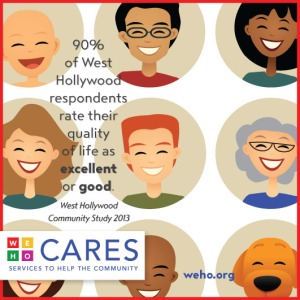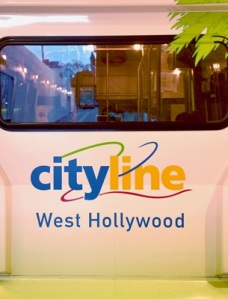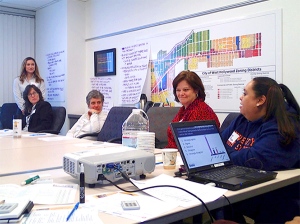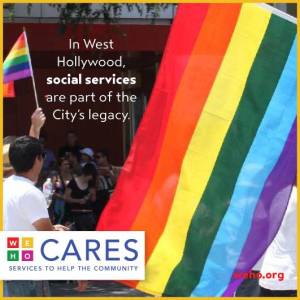There’s no place like home. This is true for the residents of the vibrant and eccentric city of West Hollywood, or “WeHo” as it’s lovingly known. When the City of West Hollywood’s Social Services Division conducted its 2013 Community Study it discovered that 90% of its residents responded that they have a good or excellent quality of life. Can you say the same about the place you live?
West Hollywood is home to the Sunset Strip, Santa Monica Boulevard, and the Avenues Design District. It has a land area of less than two miles. Here you can run errands and get to and from restaurants, bars, shopping and services all without a car. It is one of California’s most walkable cities according to Walkscore.
Its population of around 35,000 is as diverse as its land uses. Its residents are known for being socially minded. They are made up of various cultures, ages, religions and sexual orientations. It is also the second most concentrated Russian-speaking region in the United States.
With a city this compact and diverse, which services are most important? That was the question. The City’s Social Services Division set out to engage, listen to and learn from its residents during its 2013 Community Study to develop recommendations for the allocation of general funds and to update the city’s demographics. The Social Services Division used creative and flexible opportunities for public participation to bring the Study to the people. This type of engagement helped the City of West Hollywood to win one of the two 2013 International Association of Public Participation USA Core Values Awards for Project of the Year.
This week we hear from Corri Planck, the Program Administrator for the City of West Hollywood’s Social Services Division. She shares with us the unique and collaborative approach to public participation that was used with the 2013 Community Study. An approach to public participation that is sure to be part of the city’s legacy.
– – –
What is the Social Services Division’s role at the City of West Hollywood?
The Social Services Division for the City of West Hollywood has a rich and deep history of ensuring service and support for our community members. Though a collaborative funding process, the Social Services Division monitors $4.2 million annually in social services contracts.
In addition, the Division manages a variety of transit programs; develops and coordinates social and educational programming for a diverse range of issues and populations; and responds directly to constituent needs.
What findings were you hoping or expecting to gather from this year’s Community Study?
The purpose of the study was three-fold. We wanted to update our City’s demographics; develop actionable recommendations for the $4.2 million of general fund dollars allocated for social services contracts; and make sure we could continue to best understand West Hollywood and its residents.
What was your outreach approach and how early did you begin generating interest in the Community Study?
This was an exceptionally ambitious project – in its scope, in its commitment to unprecedented community engagement and certainly in its timeline. We began in January, and held our last community event in March. A preliminary summary report was issued in April, with the full, final report published in early August.
Our planning for the Community Study included a thorough outreach and communications strategy that utilized a full range of the City’s resources to get the word out. Our commitment was to consistent, constant communication.
There were the standard flyers, postcards, and posters as well as banners in our two major City parks. We crafted nine news releases on various stages of the process, placed an article in the City newsletter, worked with our Public Information Office to script a special episode of #trending, a magazine style talk show, exclusively dedicated to the Study on WeHo TV. We created a social media presence, and all printed materials were available in English, Russian and Spanish (including the survey itself). We created a special webpage dedicated to the Study that was updated throughout the process, and benefitted from the e-mail signatures with the Community Study logo and hyperlink that our City staff members added to their outgoing messages.
We also relied on old-fashioned, face-to-face communication. Our Social Service staff and the City’s Human Service Commissioners visited every City Advisory Board and Commission, some more than once, during this process to keep them informed. We were able to utilize the Neighborhood Watch e-mail lists to engage residents, and did direct outreach to the West Hollywood-serving social service agencies. In addition, staff members generated multiple e-mails and phone calls to invite community members to participate in a number of the opportunities, from focus groups to stakeholder interviews to attending community meetings.
This year’s Community Study attracted a record high number of responses. Is there a single tactic or public participation event that created more interest to have the influx of new survey participants?
Our commitment to consistent and constant communication aided us across the board in increasing the level of participation.
We added pop-up workshops to this year’s process, guided by the idea of taking the public meeting to the people. We “popped up” in multiple locations throughout the City on various days and times.
Participants were able to engage in multiple activities, all designed to solicit their priorities for social services – target populations, service areas and budget priorities. It allowed people to give us their time as they chose – one of the activities could take 10 seconds, and others could engage people for 15-20 minutes. It was a really great way for us to hear from people who might not ever attend a traditional community meeting.
The last Community Study was conducted in 2006. What are the most notable differences in how the Community Study was carried out between now and then?
The major difference was the addition of the community engagement activities — pop-up workshops — which took the study to the people.
Were you surprised by any of the feedback you gathered?
More than surprising, there were moments in this process that were completely inspiring, and it was absolutely affirming of the City of West Hollywood’s core values.
We found that 88% of residents rated as excellent or good the job the City is doing to provide services, and 90% rated their quality of life as excellent or good.
Last year, nearly 10,000 of our community members utilized a social service – whether it was a home-delivered meal or an HIV test or a shelter at night or an after-school program or any number of other services we provide. That’s nearly one-third of our total population.
The City’s commitment to social services is clearly a source of pride for our community members as well. The provision of social services is part of the City’s legacy and our residents feel a sense of shared ownership in this core value, in this ideal.
How do you plan to share the Study’s findings with the West Hollywood community?
The findings of the Community Study were put to immediate use by the Human Services Commission, our City Council and prospective partner agencies as part of the funding process for our Social Services contracts. The needs that were articulated in the Community Study process were directly addressed in that funding process – resulting in new providers, increased access to mental health services, and additional options for substance abuse services and programs.
We continue to report back to various City advisory boards and commissions, to our City staff and the Study itself has been made available to the public since it was published.
Some of the findings were just so great that we felt we should find additional, creative ways to share the info. We created a series of graphics to utilize via social media and as e-mail signatures.
What changes will you make, if any, to your next outreach campaign?
Because the City has a history of conducting these Community Studies, there are elements that will remain the same over time, primarily to ensure the consistency and validity of the comparisons over time. That said, it’s probably too early to commit to potential changes in outreach, given the speed at which technology and communications is changing. Our primary commitment, however, will remain the same – to secure the highest levels of community engagement possible.
What do you think is the most important act a local government can do to foster constructive public dialogue?
To foster engagement on a regular basis — provide information, ask questions, and listen. To ensure that we truly engage with our community and that we strive to do so in real, meaningful and purposeful ways.
– – –
Thank you Corri for sharing your insights with us. Taking the Study to the people is a great way to make it easier for them to get involved.
Liz Faris, Account Manager
Collaborative Services, Inc.







Recent Comments